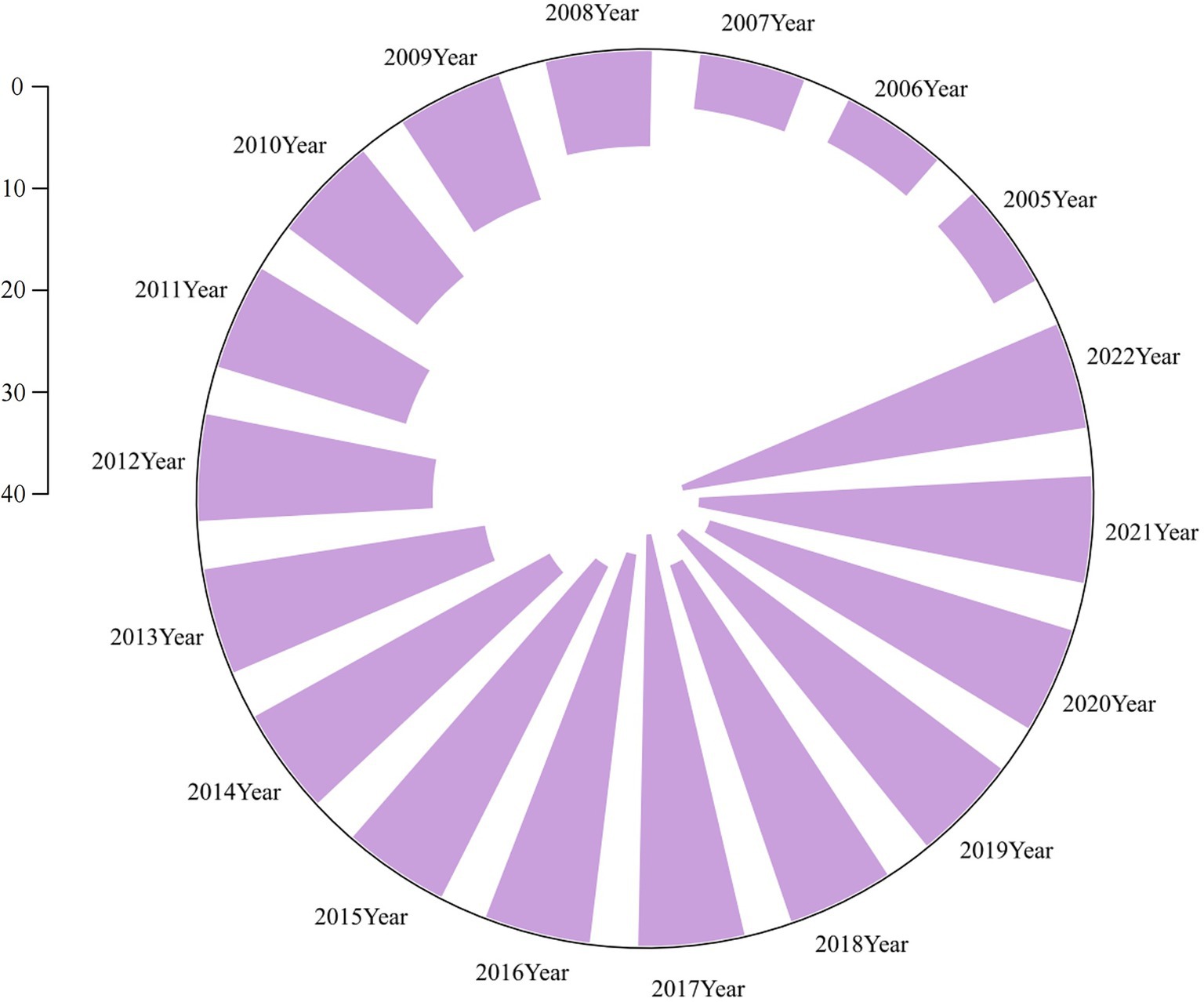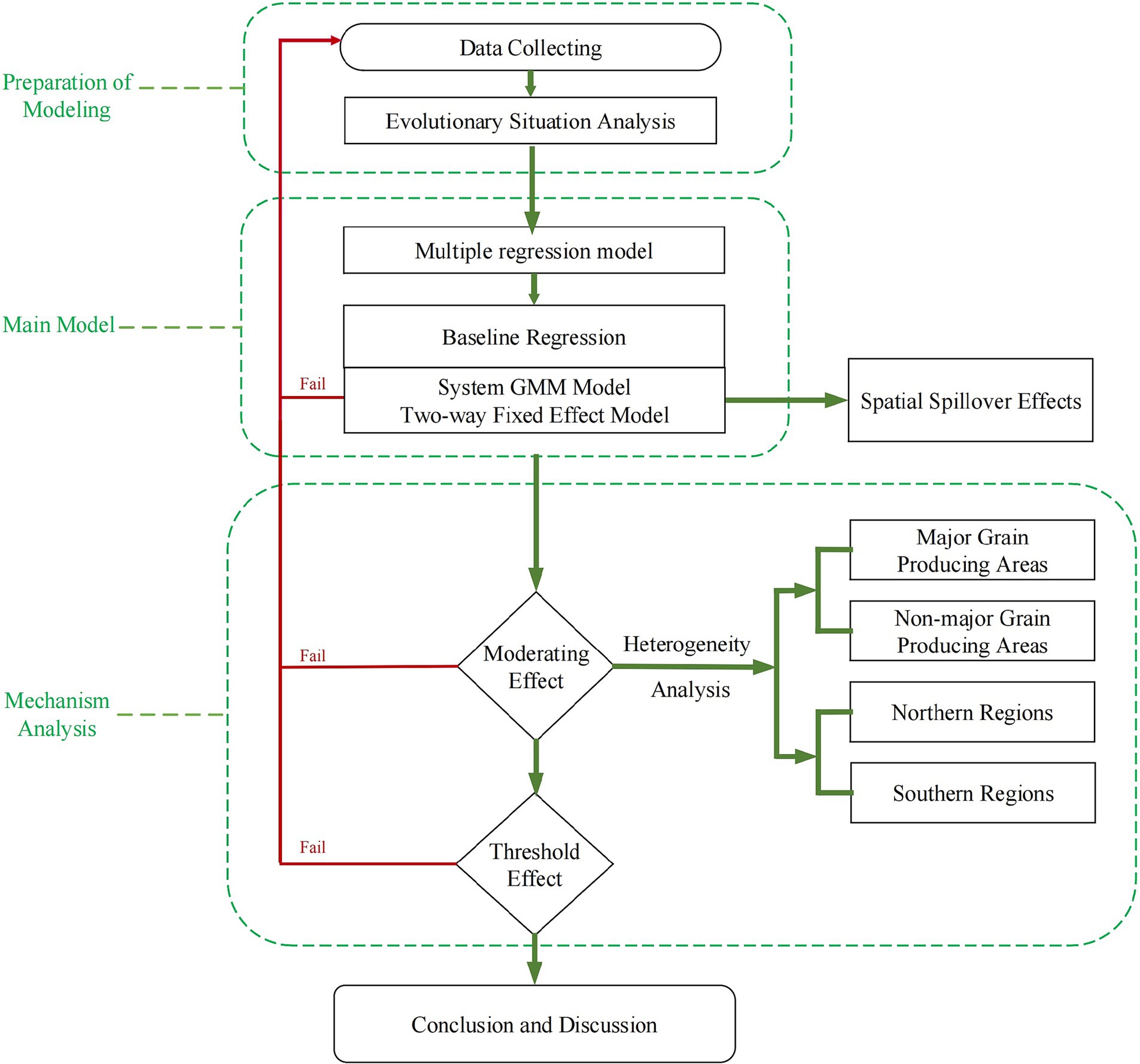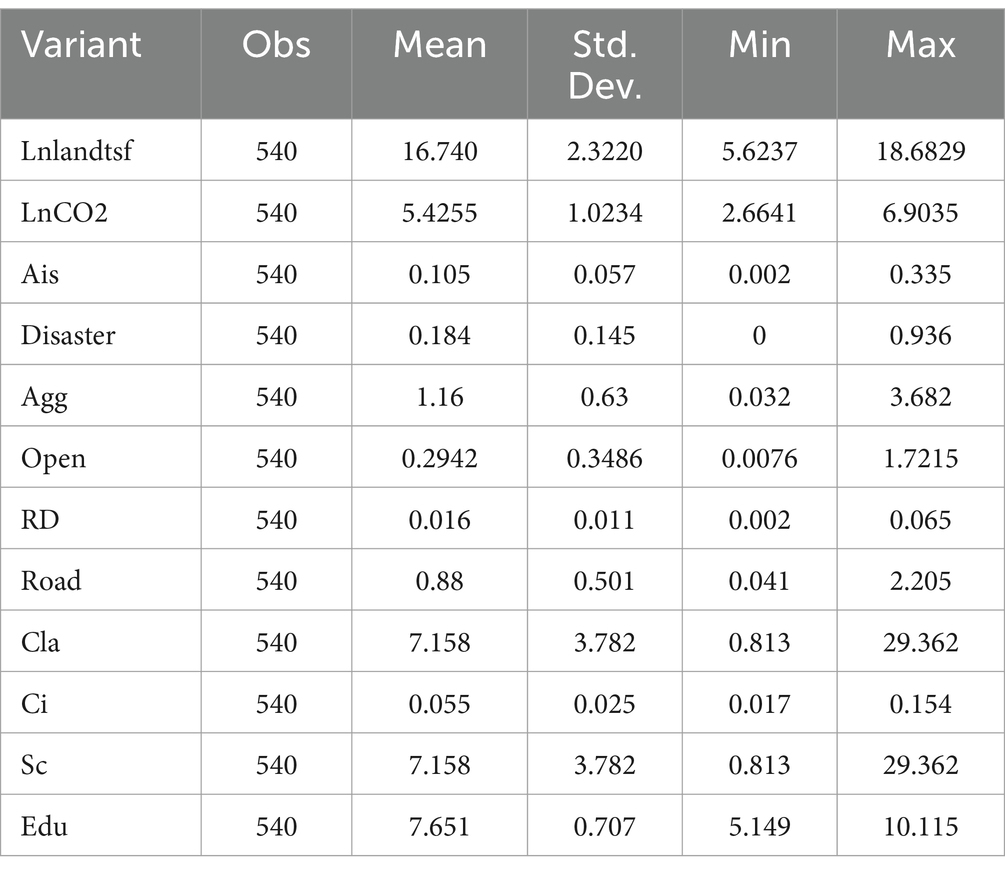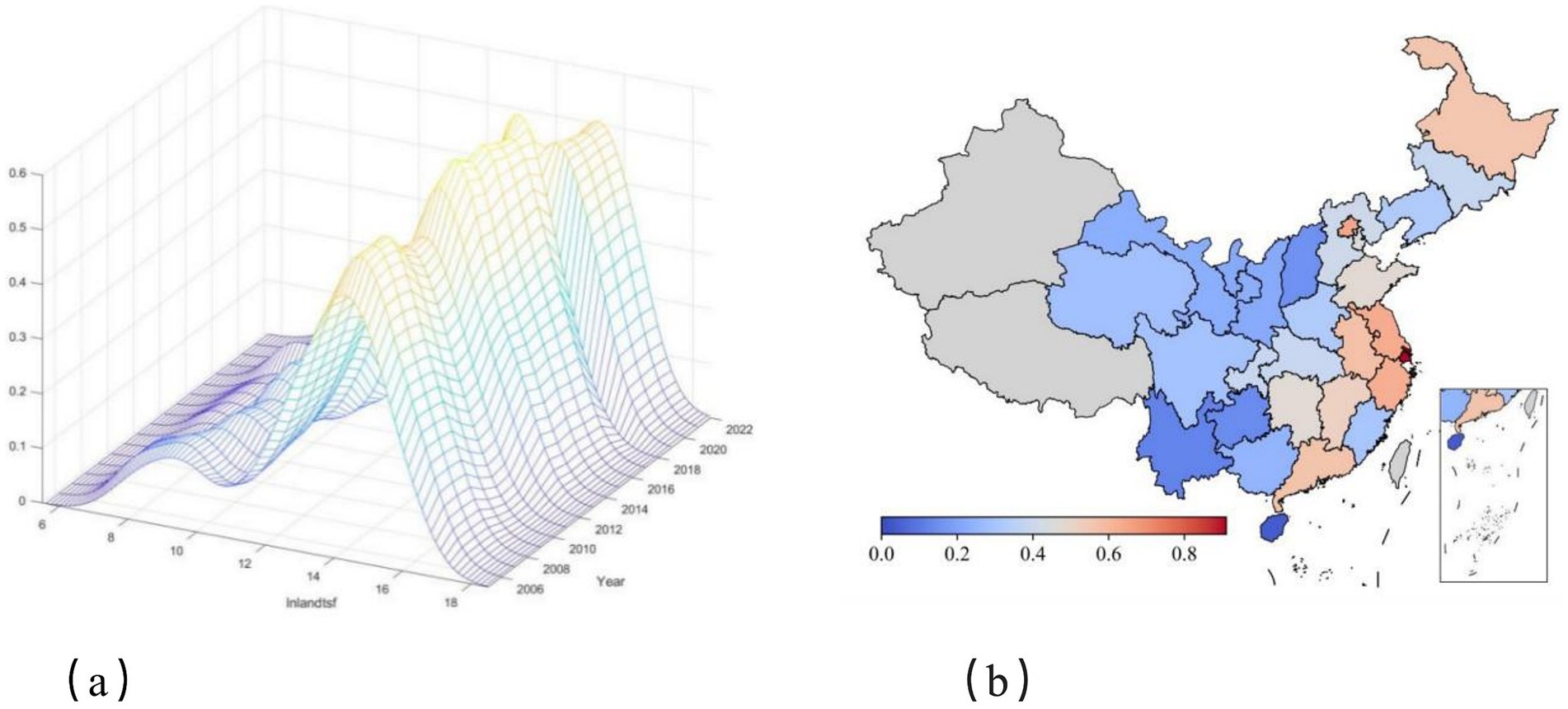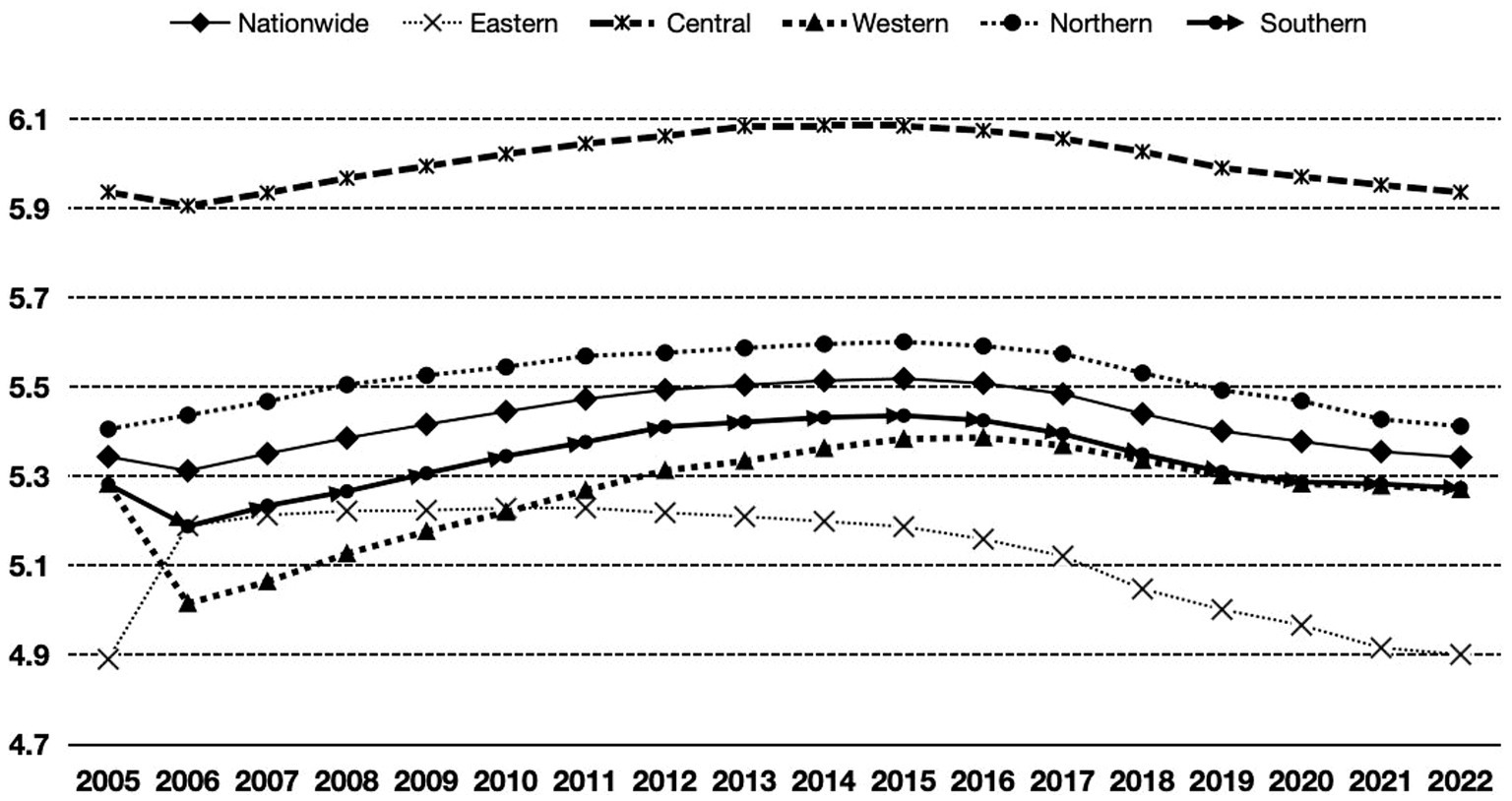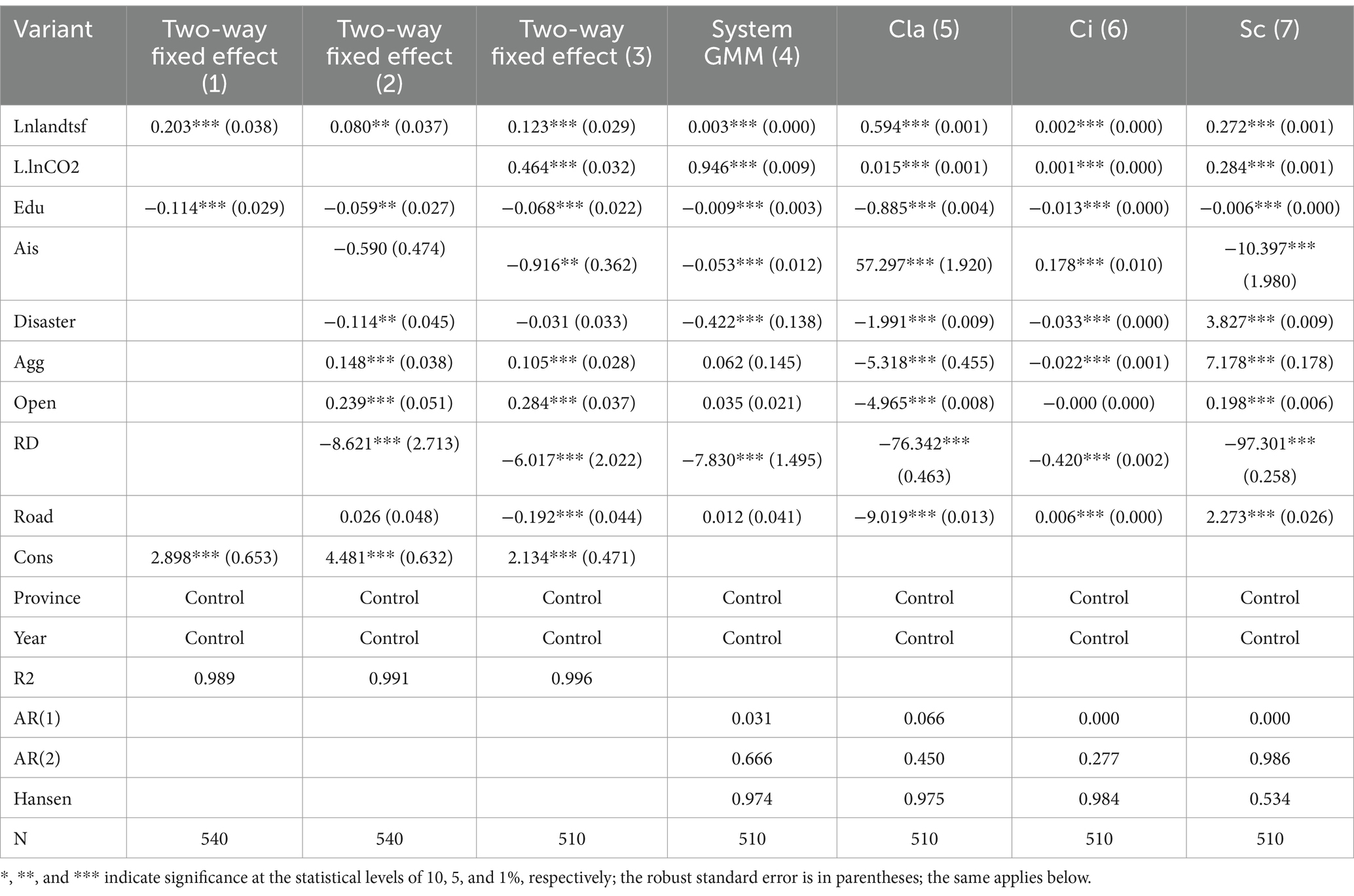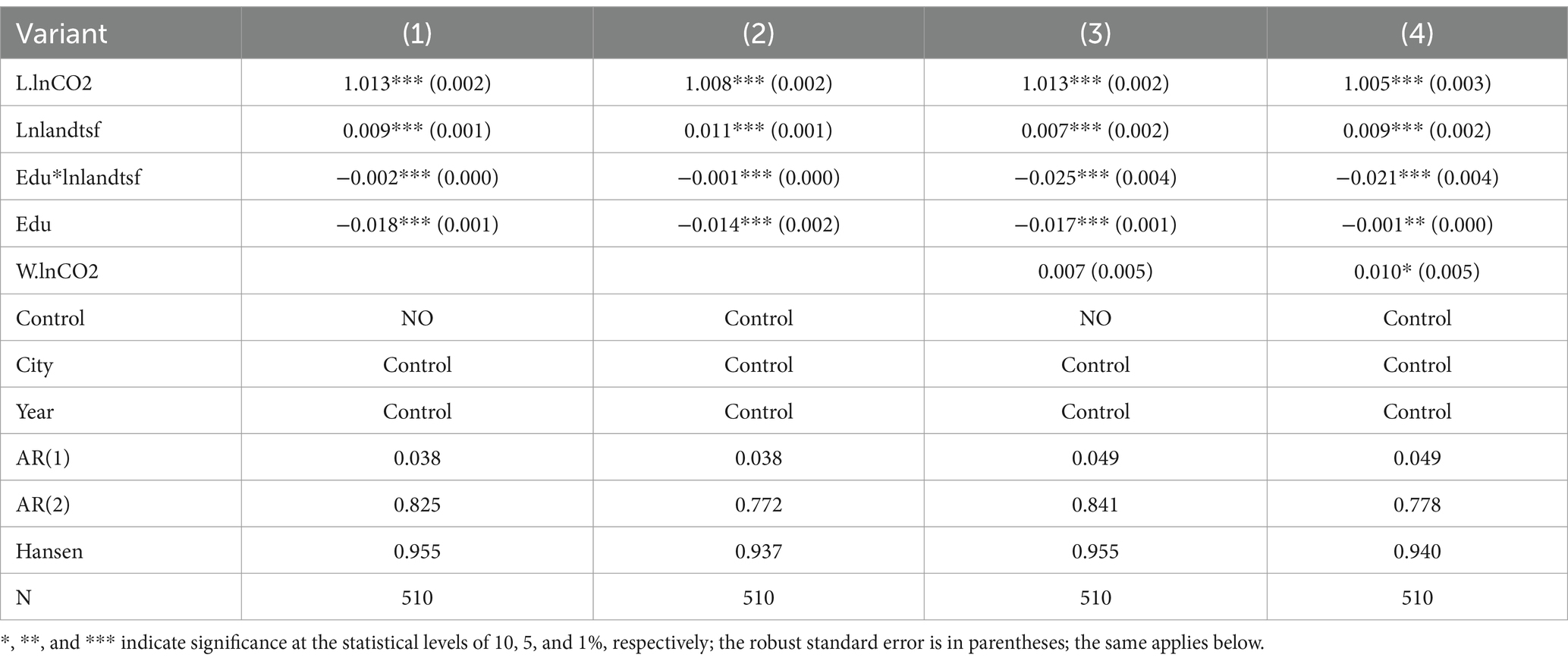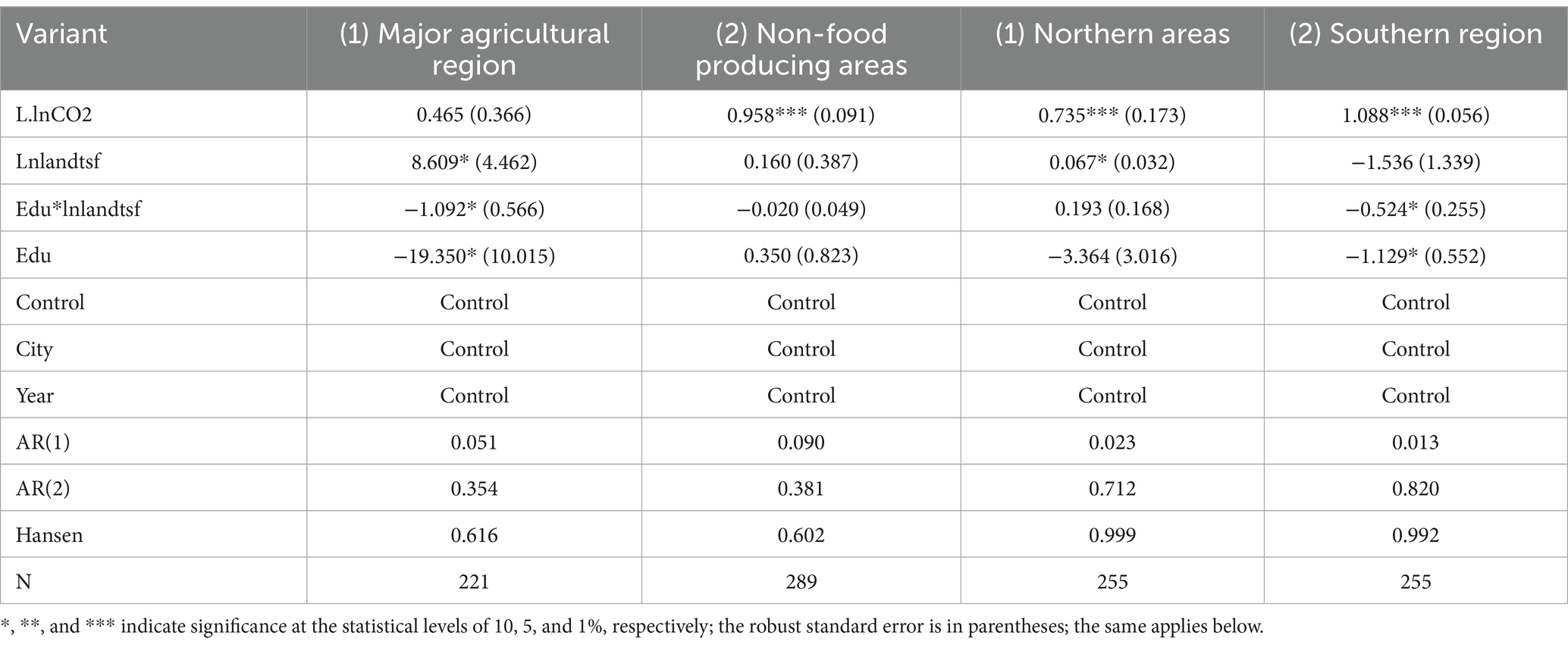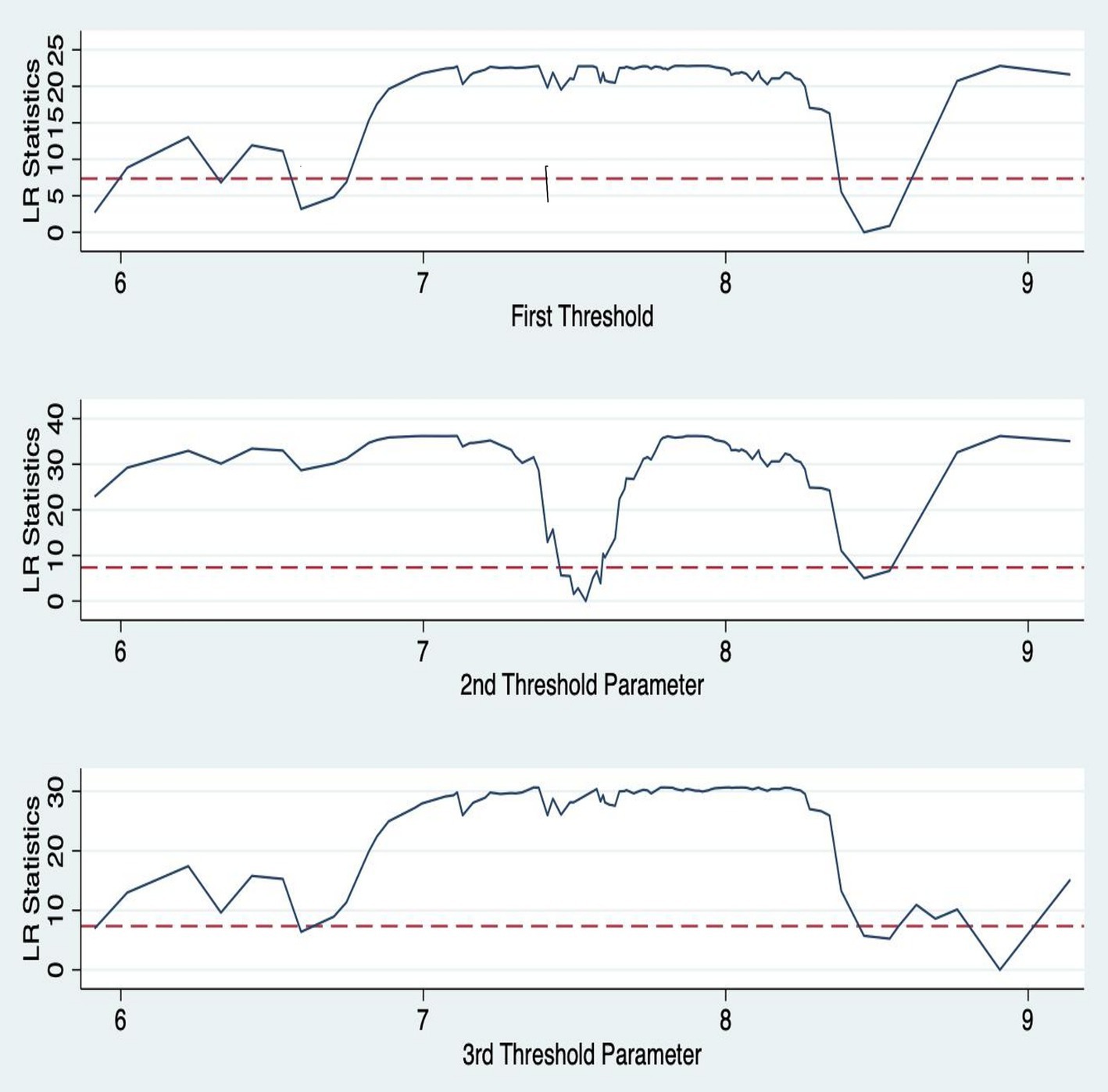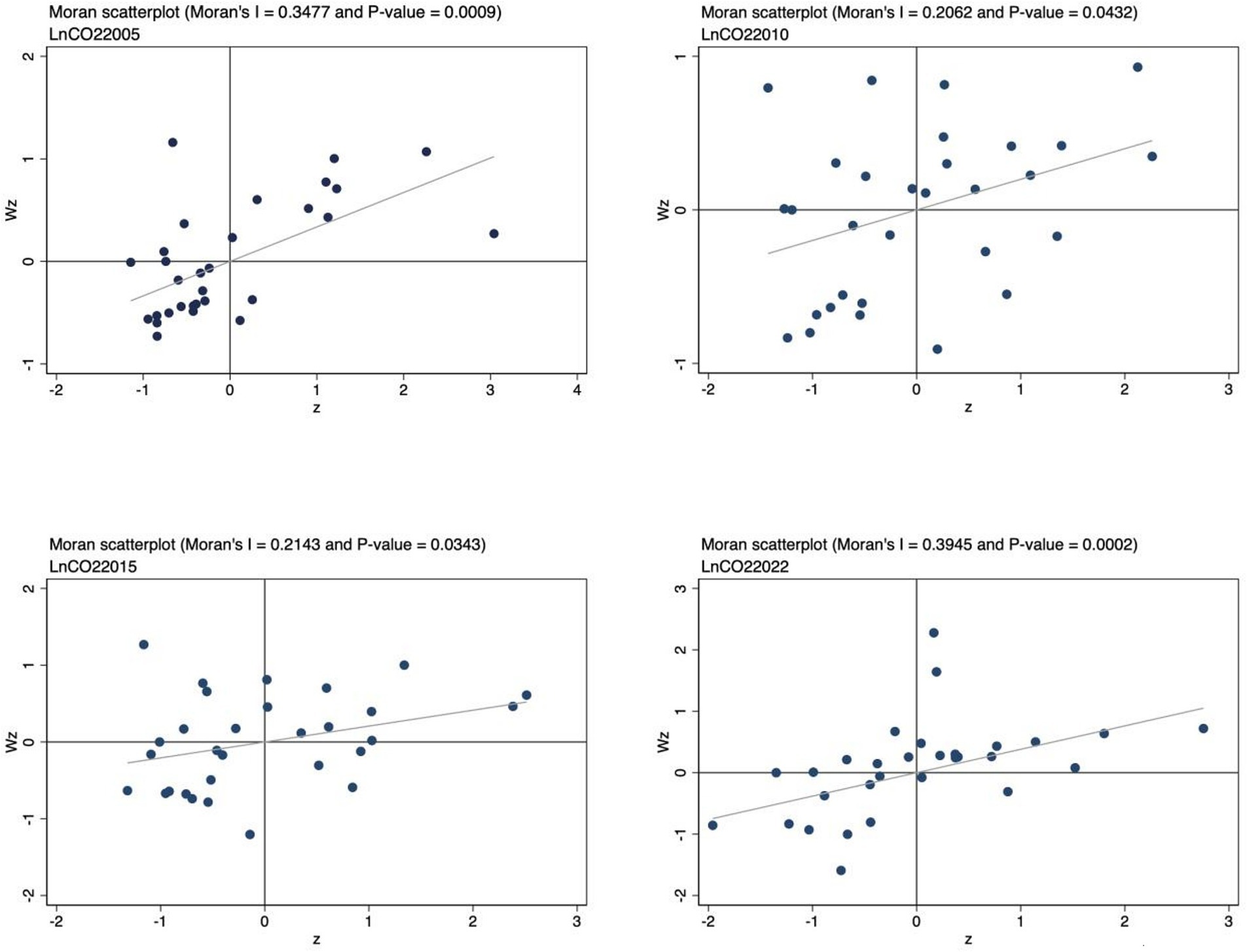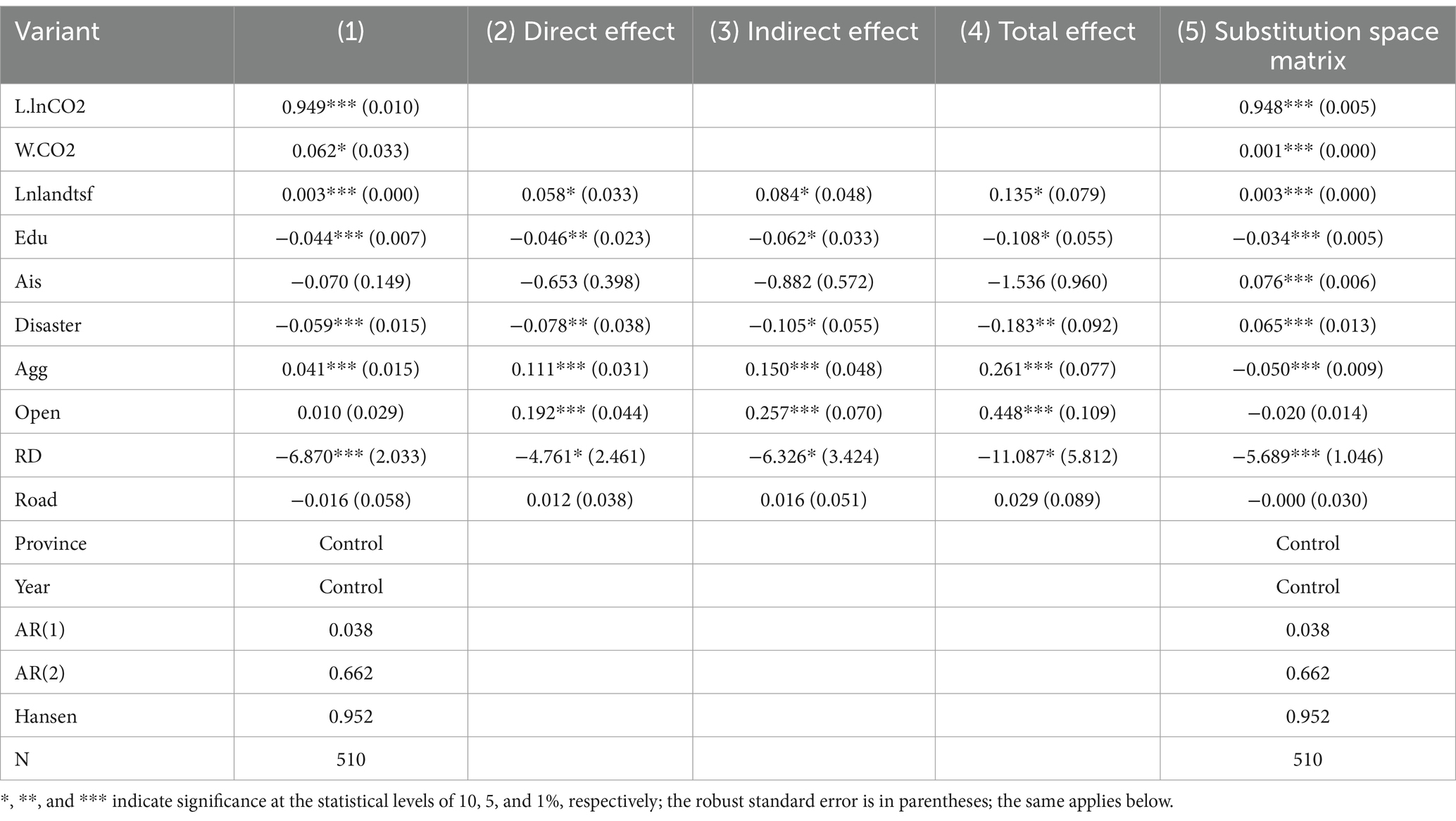- 1College of Economics and Management, Nanjing Forestry University, Nanjing, China
- 2Huai'an City Taxation Bureau, Huaian, China
- 3College of Economics and Management, Nanjing Agricultural University, Nanjing, China
Research has found that the transfer of agricultural land in China has to some extent led to agricultural carbon emissions. Therefore, it is urgent to systematically analyze the reasons for carbon emissions caused by agricultural land transfer, find ways to mitigate the increase in agricultural carbon emissions, and achieve low-carbon and sustainable development of agriculture. This article analyzes the relationship between agricultural land transfer, rural human capital, and agricultural carbon emissions in 30 sample provinces in China based on property rights incentives and scale operation theory, using the system GMM model, adjustment model, and threshold model. The results indicate that the transfer of agricultural land has, to some extent, intensified agricultural carbon emissions, with an increase of 0.003 units per unit of agricultural land transfer intensity. Rural human capital has mitigated the carbon emissions resulting from agricultural land transfer and played a corrective role. Under varying levels of rural human capital, there exists a dual threshold effect on the impact of agricultural land transfer on carbon emission intensity, exhibiting a pattern of ‘ineffectiveness-promotion-inhibition’. The analysis of regional heterogeneity reveals significant differences in the relationship between agricultural land transfer and carbon emissions between major grain-producing areas and non-grain-producing areas. It is worth noting that in the northern region, the transfer of agricultural land exacerbates carbon emissions, whereas in the southern region, higher levels of rural human capital effectively curb the growth of carbon emissions. Furthermore, the impact of agricultural land transfer on carbon emissions is not confined to specific regions, indicating that its environmental consequences transcend administrative boundaries and spread geographically, displaying distinct time-dependent characteristics.
1 Introduction
At present, the problems of fragmented farmland management, outdated agricultural technology, and production factors are difficult to meet the needs of China’s agricultural modernization, green and sustainable development. To achieve the scale, intensification, and modernization of agricultural management, the transfer of rural land management rights (hereinafter referred to as agricultural land transfer) is regarded as an important stage in the reform of China’s rural land system. It provides the necessary foundational conditions for accelerating the modernization of agriculture and rural areas and comprehensively promoting the revitalization of rural industries.
Agricultural land transfer is based on the reasonable transfer of land management rights to expand the scale of agricultural management and ultimately achieve resource intensification. By the end of 2022, the total area of family-contracted arable land transferred by farm households nationwide had grown from 0.13 billion mu in 1996 to 576 million mu, and the proportion of the total area of family-contracted arable land increased from 0.98 to 36.72% (see Figure 1). Studies have shown that farmers’ farmland transfer behavior is influenced by property rights stability (Zhou and Luo, 2023; Li and Zhu, 2023) the form of rent (Wu et al., 2023), government intervention (Wu and Liu, 2020), family and social characteristics (Liu et al., 2023; Huang et al., 2023) and factors such as the appropriateness of engaging in non-farm industries. Meanwhile, most scholars believe that the transfer of agricultural land, as an important way of allocating land resources, facilitates the reorganization of agricultural factors with land as the core, helps ensure the stability of land rights, improve farming efficiency (Fei et al., 2021), and promotes the transfer of rural laborers (Wang J. Y. et al., 2020), thus resulting in increased agricultural production and farmers’ income (Peng et al., 2020; Ding et al., 2024). Agricultural land transfer plays an important role in promoting medium-scale agricultural operations, increasing agricultural mechanization, improving the efficiency of agricultural land utilization, and promoting agricultural productivity (Yan et al., 2019; Yu et al., 2022). Conversely, it is believed that the transfer of agricultural land has fallen into the predicament of agricultural “involution,” leading to an increase in the phenomenon of “small farmer replication,” a decrease in the efficiency of agricultural production, and it is not conducive to the improvement of non-agricultural employment and farmers’ income (Liu et al., 2019; Yuan and Wang, 2022; Fei et al., 2021).
In recent years, existing studies have also discussed the impact of agricultural land transfer on environmental effects, primarily focusing on its influence on agricultural surface pollution and fertilizer use (Lu and Xie, 2018; Mugizi, 2022). However, the impact of agricultural land transfer on agricultural carbon emissions has not yet been adequately discussed, and no consistent conclusions have been reached. Scholars, such as Liao et al., have found that land transfer could improve the level of agricultural mechanization, promote the transformation of traditional agriculture to modern agricultural production and management modes of specialization and scale, and have economic and ecological effects that reduce agricultural carbon emissions (Liao et al., 2023). On the other hand, some scholars believe that the transfer of agricultural land has increased agricultural carbon emissions by expanding the sown area of crops, adjusting the planting structure, and increasing agricultural material inputs. For example, Long Yun found that smallholder land transfer may increase the intensity of inputs such as fertilizers and lead to higher agricultural carbon emissions. When the development of the agricultural land transfer market is imperfect, the intensive land use and large-scale mechanized production brought about by agricultural land transfer can result in increased agricultural production carbon emissions (Long and Ren, 2016). Additionally, regarding the research methodology of agricultural land transfer, scholars tend to use static panels as well as traditional econometric methods such as OLS, two-way fixed effects, and quantile regression. There are relatively few studies that explore threshold effects and spatial analyses.
In the context of the continuous promotion of market-oriented agricultural land transfer, clarifying the relationship between agricultural land transfer and agricultural carbon emissions is closely related to sustainable development goals and spatial sustainability principles. This clarification is of great significance for promoting China’s rural land system and developing ecological low-carbon agriculture. Regarding sustainable development goals, the environmental effects of agricultural land transfer directly affect the achievement of these goals, providing Chinese cases and references for achieving global climate targets and promoting emission reduction actions in the agricultural sector. In terms of spatial sustainability, paying attention to the spatial spillover effects of agricultural land transfer on agricultural carbon emissions can help formulate more precise regional policies and promote the spatial balance and sustainable development of agricultural production.
Empirical studies have already demonstrated that large-scale collective farming and agricultural land transfer are major trends, and that land transfer for the purpose of large-scale management is a necessary foundation for accelerating agricultural and rural modernization, as well as promoting the revitalization of rural industries (Liu et al., 2024). Therefore, it is important not to simply dismiss the value of agricultural land transfer in light of potential environmental challenges. Instead, there should be active exploration of new approaches and mechanisms to mitigate or improve the carbon emission effects associated with agricultural land transfer. This will help ensure the sustainability and environmental friendliness of agricultural land transfer policies.
Indeed, the role of rural human capital is crucial in the context of agricultural land transfer and the pursuit of green agricultural development. Rural human capital, as a core production factor in agricultural development, plays a significant role in promoting the transfer of agricultural land and achieving sustainable agricultural practices (Wang W. W. et al., 2022; Ren et al., 2023; Zhong et al., 2008). However, the current research on rural human capital in relation to the relationship between agricultural land transfer and agricultural carbon emissions is still limited. This presents an opportunity for new research perspectives and critical analysis. It is necessary to strengthen research efforts focused on rural human capital, delving into the mechanisms through which it influences the process of agricultural land transfer. Additionally, exploring how improving the level of rural human capital can mitigate or improve the carbon emission effects of agricultural land transfer is crucial. This will help us gain a more comprehensive understanding of the relationship between farmland transfer and agricultural carbon emissions, provide strong support for formulating more scientific and reasonable farmland transfer policies, and offer new pathways for better achieving sustainable development goals and spatial sustainability.
Accordingly, this paper aims to expand the existing literature from the following aspects: (1) Few studies have utilized static panel analysis to examine the impact of agricultural land transfer on agricultural carbon emission intensity; however, the channels of its influence and the spatial mechanisms need further exploration. Therefore, this paper examines the role and spatial spillover effects of agricultural land transfer on agricultural carbon emission intensity based on the theory of property rights incentives and economies of scale, using dynamic panel data from 30 sample provinces in China from 2005 to 2022. (2) Although scholars found that the transfer of agricultural land led to an increase in the intensity of agricultural carbon emissions, they did not further explore ways to improve the increase in carbon emissions due to the transfer of agricultural land. Therefore, in this paper, rural human capital is included in the analytical framework between agricultural land transfer and agricultural carbon emissions, and its corrective effect on carbon emissions from agricultural land transfer is analysed using the moderating effect and threshold effect. (3) In addition, based on the positioning of agricultural development and geographic heterogeneity, this paper compares the differences in the impacts of carbon emissions from the transfer of agricultural land between the main food-producing areas and non-food-producing areas, and different regions.
2 Theoretical logic of the impact of agricultural land transfer on agricultural carbon emissions
2.1 The impact of agricultural land transfer on agricultural carbon emissions
The theory of property rights incentives suggests that the stability of land management rights is a key factor influencing farmers’ long-term investments, the cropping structure of farm households and agricultural production methods (Mugizi, 2022; Séogo and Zahonogo, 2023). On the one hand, the main body of agricultural land transfer, due to differences in property rights attributes and unclear definitions of environmental responsibilities between the contracting parties, may lead to an increase in carbon emissions released in the form of agricultural means of production due to the transferee’s extensive use of fertilisers, pesticides, and machinery and equipment in pursuit of profit maximisation. Lu et al. found that the stability of land property rights will affect the amount of farmers’ use of organic fertilisers and chemical fertilisers (Lu et al., 2019). Subramanian et al. used experimental data on farmers’ access to formal land ownership in India and found that land property rights are important in terms of agricultural productivity, and agricultural investment (Subramanian and Kumar, 2024). On the other hand, recipients of agricultural land transfers may adjust the structure of agricultural cultivation, such as increasing the area under cash crops or shifting to high-yield crops (Tan et al., 2023). Certain high-yield cash crop cultivation may require more chemical fertilisers and pesticides, leading to an increase in agricultural carbon emissions. In addition, agricultural production methods are also constrained by the duration of transfers and land rents, and farmers may favour economic efficiency over environmental efficiency (Li X. H. et al., 2023; Li B. et al., 2022).
More importantly, the implementation of the agricultural land transfer policy in China has led to a reduction in land abandonment (Qiu et al., 2024) and an expansion of cultivated and irrigated areas for farmers. This increase in agricultural land use is the main and direct cause of the rise in agricultural carbon emissions (Ji et al., 2023). Specifically, farmland transfer allows farmers to transfer land they are unwilling or unable to cultivate to others for management, thereby avoiding idle and wasteful use of land resources. As a result, the cultivated land area expands, indicating that more soil is being used for agricultural production. This, in turn, leads to an increase in carbon emissions from crop, soil, and microbial production processes (Ji et al., 2023). CH4 and N2O emissions from crop cultivation on agricultural land are the main sources of agricultural carbon emissions.
In the long term, with the realisation of appropriate farmland scale operation, it will help to introduce more efficient agricultural technologies and management methods, and reduce agricultural carbon emissions (Ren et al., 2023; Li J. K. et al., 2022). However, at present, China’s current scale of farmland operation is very small, with small-scale subcontracting and transfer between farmers dominating the mainstream, and fewer leading enterprises and large professional households focusing on transferring land on a large scale and engaging in comprehensive agricultural development; more than 70 per cent of arable land belongs to small-scale operation, and there are still 210 million farmers whose farmland area is less than 0.6 hectares (Xu et al., 2020). From the perspective of economies of scale, the current situation of agricultural land transfer is not conducive to fertiliser reduction and low-carbon agricultural development. In addition, the transfer of agricultural land expands the land area, but does not necessarily bring the effect of parcel consolidation, and it is also common for one farmer to operate multiple independent land parcels (Zhang and Chen, 2021).
It can be seen that the transfer of agricultural land itself is not the fundamental reason for the increase in agricultural carbon emissions. At present, the increase in agricultural carbon emissions is mainly due to the reduction of fallow land, the expansion of farmers’ planting and irrigation areas, the increase in chemical inputs, the small scale of agricultural land, and the imperfect policies of agricultural land transfer. Therefore, based on the above analysis, this article proposes hypothesis 1: Currently, due to the expansion of cultivated land planting area, increased chemical input, and small scale of agricultural land, the transfer of agricultural land has to some extent exacerbated the intensity of agricultural carbon emissions.
2.2 The regulating role of rural human capital
Rural human capital plays a crucial role in driving agricultural modernization and rural revitalization. Does the improvement of rural human capital level help to suppress the carbon emission effect of current agricultural land transfer? The answer is yes. Firstly, agricultural producers with higher levels of human capital can more effectively access information, acquire new skills (Chen et al., 2024; Satriawana and Swinton, 2007), comprehend green agricultural production technologies and methods, manage and operate transferred farmland more efficiently, recognize the economic benefits of green agricultural products, and adopt environmentally friendly and efficient agricultural production methods (Zang et al., 2022), thereby reducing agricultural carbon emissions. Secondly, farmers with a higher stock of human capital often receive a more extensive general or professional education. This education equips them with strategic decision-making abilities during agricultural land transfer and enables them to consider environmental factors when selecting appropriate agricultural management methods, partners, and land utilization techniques. As a result, they can contribute to the improvement of agricultural land transfer policies. Furthermore, the enhancement of agricultural labor quality can promote the scaling of agriculture, the upgrading of the agricultural industrial structure (Wang H. et al., 2020), the adoption of modern agricultural technology and equipment, the promotion of ecological practices, branding, and diversification of agriculture. It also helps reduce the excessive use of agricultural land resources and the associated carbon emissions (Shi et al., 2023).
In conclusion, the increase in rural human capital level brings about improvements in farmland scale and the low-carbon development of agriculture. This, in turn, may lead to a significant reduction in agricultural carbon emissions through transformative changes in farmland transfer. Based on the above analysis, this article proposes hypothesis 2: Rural human capital plays a negative regulatory role in the relationship between increasing agricultural carbon emissions through land transfer.
2.3 Spatial effects of agricultural land transfer on agricultural carbon emissions
Theoretically, the impact of any behavior or decision in a certain region will spread to other regions and produce spillover effects, and the transfer of agricultural land is no exception. Local agricultural land transfer can help promote non-farm employment of farm households, expand agricultural scale, reduce land abandonment, etc., which in turn brings certain economic benefits (Yan et al., 2019; Peng et al., 2020), while the government’s supportive measures for the agricultural land transfer policy may have a demonstration and diffusion effect in the local area, which may attract agricultural producers in the neighbouring areas to also carry out the transfer, and thus have a significant impact on the agricultural land transfer in the neighbouring areas. Transfer, which in turn has an impact on agricultural carbon emissions in neighbouring regions (Zhou and Zhang, 2023). In addition, if local agricultural land transfer affects the structure and scale of agricultural production, leading to the redistribution of agricultural production among different regions, it may have an impact on the entire agricultural industry chain, thus changing the spatial distribution of carbon emissions. And the agricultural products it produces will also bring corresponding carbon emissions during circulation and processing, thus affecting the agricultural carbon emissions in the neighbouring regions.
Based on the above analysis, this paper proposes hypothesis 3: the transfer of agricultural land has a spatial effect on agricultural carbon emissions, meaning that local agricultural land transfer may influence agricultural carbon emissions in neighboring areas.
3 Study design and data sources
3.1 Experimental process
In order to better demonstrate the empirical testing process of the article, we have constructed an empirical flowchart as shown in Figure 2:
3.2 Model setting
3.2.1 Basic model
This article establishes a multiple regression model (1) to identify the impact of agricultural land transfer on agricultural carbon emissions, and estimates it using bidirectional fixed effects. However, previous studies have shown that agricultural carbon emissions exhibit significant temporal correlations and dependency characteristics. Therefore, it is necessary to consider the dynamic impact of past agricultural carbon emissions on the current period. To address this, the lag period of agricultural carbon emissions is included in the model, and a dynamic panel model is used to better capture this dynamic effect (Li Y. et al., 2023). Therefore, this study establishes model (2) to identify the temporal correlation and dependence characteristics of agricultural land transfer on agricultural carbon emissions. Meanwhile, a system GMM model that can effectively alleviate endogeneity issues is adopted to estimate Equation 2.
In addition, to verify hypothesis 1, this study constructed model (3) using dynamic panel data and mediation effect models to analyze the mechanism of agricultural land transfer on agricultural carbon emission intensity.
Where is the intercept term; denotes the regional annual agricultural carbon intensity, denotes agricultural land transfer, is the ensemble of control variables, and denotes the lagged term of ; denotes the time fixed effect; is the regional fixed effect; and is the random perturbation term. is the mediator variable.
Moderating effect model of rural human capital.
In order to test hypothesis 2, whether rural human capital has a moderating effect on the relationship between the transfer of agricultural land affecting agricultural carbon emissions, the following regression model is constructed:
represents the level of agricultural human capital.
3.2.2 Building spatial lag model
To test hypothesis 3, we constructed a spatial model to verify the spatial impact of land transfer on agricultural carbon emissions. However, the specific spatial model to be used for verification requires model identification and validation (see Table 1 for detailed results). The Hausman test suggests that it should be set as a fixed effect. The LM test and Robust LM only have spatial errors. Robust LM_Spatial error cannot reject the null hypothesis, so the spatial lag model and LR test can significantly reject the null hypothesis. Therefore, this paper sets the econometric model as a double fixed effects spatial lag model.
Meanwhile, considering the dynamic impact of previous agricultural carbon emissions on the current period, this paper constructs Equation 5 to verify the spatial impact of agricultural land transfer on agricultural carbon emissions (Wang Y. et al., 2022):
Equation 5 where is the spatial weight matrix, this paper uses the commonly used binary spatial adjacency matrix, and also uses Equation 6 economic-geographical nested matrix to replace the spatial adjacency matrix for robustness testing.
is the total number of spatial units; and represent the attribute values for region and region , respectively, and is the mean of the attribute values for all spatial units. >0 indicates that the examined data have positive spatial correlation and that the regional observations tend to be clustered, while <0 is the opposite.
The practice of determining the presence of spatial spillovers in model (5) through the point estimate coefficients may lead to erroneous conclusions, therefore, in this paper, the generalised spatial Equation 8 is written in the biased form (9) as a way of determining the presence of spatial spillovers:
3.3 Variable selection
The explanatory variable is agricultural carbon emission (lnCO2), which is accounted for by fertiliser, pesticide, agricultural film, diesel fuel, sowing and irrigation area and their carbon emission coefficients in the agricultural production process and subsequently taking logarithms. Referring to the research of relevant scholars, the formula for calculating agricultural carbon emissions is shown in Equation 10 (Zhu et al., 2022).
is the total carbon emissions from agriculture; is the carbon emissions from each type of agricultural material; is the amount of carbon sources in category ; and is the emission factor for carbon sources in category .
Core explanatory variable: Using the logarithm of the total area of household contracted farmland transfer in each province as a specific indicator of farmland transfer (Ding et al., 2024).
3.3.1 Moderating variable
The level of rural human capital (Edu) is represented by the years of education received by rural residents (Yang and Wang, 2023). the level of rural human capital (Edu) is expressed using the number of years of education of rural residents, which is an important indicator of an individual’s knowledge level, cognitive ability, and learning ability. The average number of years of education of rural residents = (number of people not attending school × 0 + number of people of preschool age × 3 + number of people in primary school × 6 + number of people in secondary school × 9 + number of people in high school × 12 + number of people in junior college and above × 16)/total rural population.
3.3.2 Mediating variables
Referring to relevant literature (Zhang et al., 2023; Ji et al., 2023), the sowing area (CLA) is measured using the per capita sowing area; Chemical input intensity (CI) is measured by the amount of chemical fertilizers, pesticides, films, and other chemicals used per unit sowing area. The scale of agricultural operations (SC) is expressed as the ratio of crop sowing area to agricultural labor force.
3.3.3 Control variables
Referring to relevant literature (Ji et al., 2023; Ding et al., 2024), this study uses agricultural industry structure, agricultural industry agglomeration, degree of openness to the outside world, innovation and development capabilities, and transportation development as control variables. Agricultural industry structure (Ais): using the ratio of the value added of the primary industry to the gross regional product; agricultural disaster rate (Disaster): expressed as the ratio of the affected area at the end of the year to the total sown area of crops in that year; agricultural industry agglomeration (Agg): using the entropy of the region to express the degree of aggregation of the agricultural industry, i.e., using the ratio of the total output value of agriculture, forestry, animal husbandry and fisheries of each province to that of the national agriculture, forestry, animal husbandry and fishery industry as a percentage of the gross regional product to the national gross product. The ratio of the total output value of agriculture, forestry, animal husbandry and fishery of each province to the national total output value of agriculture, forestry, animal husbandry and fishery accounts for the proportion of the regional GDP and national GDP. Openness to the outside world (Open): the ratio of the total amount of import and export to the GDP of the region; innovation and development capacity (RD): expressed by the internal expenditure of R&D funds of each province (RMB 10,000 yuan); developed degree of transport (Road): expressed by the ratio of the sum of the mileage of railway operation, inland waterways and highways to the area of the region.
3.4 Data sources and descriptive statistics
This paper takes 30 sample provinces from 2005 to 2022 as the research object, and the required data come from the official website of the Ministry of Agriculture and Rural Development, China Agricultural Yearbook, China Statistical Yearbook, China Rural Statistical Yearbook, China Rural Management Statistical Yearbook, and China Rural Policy and Reform Statistical Yearbook; for individual vacancies, interpolation is used to fill in the blanks. Specific descriptive statistics are shown in Table 2.
4 Temporal evolution of agricultural land transfer and agricultural carbon emissions
Figure 3a uses the Kernel density estimation model to analyze the dynamic evolution trend of urban and rural land transfer in China. From the perspective of distribution, the center of the density curve of agricultural land transfer in China has shifted to the right, and the kernel density curve has always had a clear peak, gradually approaching 0.6 from the initial 0.4, indicating that the level of agricultural land transfer in China has gradually improved during the sample period. Secondly, from the perspective of distribution shape, the peak value has been increasing year by year, and the density curve shows a high and steep shape, indicating a clear trend of narrowing the absolute difference in agricultural land transfer in China. Once again, there is a gradual weakening trend in the multimodal distribution pattern, indicating that the phenomenon of multipolar differentiation in China is slowly weakening. Finally, from the perspective of distribution extensibility, the left tail feature weakens, indicating that the differences in the scale of agricultural land transfer among provinces are gradually narrowing.
In addition, according to Figure 3b, it can be seen that the overall transfer rate in China is relatively low, showing an uneven trend of high in the east and low in the west. This may be because relatively speaking, the water and heat conditions for agricultural land cultivation in the eastern region are superior, the level of economic and social development is high, and the modernization and scale level of agricultural production is high. Therefore, the level of agricultural land transfer rate is much higher than that of other provinces.
Figure 4 depicts the temporal trend of agricultural carbon emissions across different regions. Overall, the intensity of agricultural carbon emissions decreased to varying degrees during the sample period, with a notable decline in the eastern region. This suggests that China has implemented a series of measures to reduce greenhouse gas emissions in the process of agricultural production and operation, and these measures have yielded significant results. In terms of fluctuation, the amplitude is similar across various regions; however, the agricultural carbon emission intensity in the central and northern regions exceeds the national average. This may be attributed to the relatively traditional agricultural structure in these regions, which primarily focuses on grain crop cultivation and incorporates a substantial amount of animal husbandry. Additionally, the agricultural industry structure in some regions is not sufficiently optimized, leading to higher agricultural carbon emissions. Conversely, the relatively high level of agricultural technology and management in the eastern and southern regions may contribute to reducing agricultural carbon emission intensity. The agricultural structure in the western region may be more uniform, primarily centered on planting, resulting in a relatively low carbon emission intensity in agriculture.
5 Model estimation results and analysis
5.1 Base regression
Firstly, this section mainly reports the regression analysis based on Equations 1, 2, aiming to explore the impact of farmland transfer on agricultural carbon emissions. By gradually introducing control variables, lag periods, and using a system GMM model for estimation, we conducted a thorough analysis of the relationship between agricultural land transfer and agricultural carbon emissions. Column (1) of Table 3 shows the basic regression results without adding control variables. Column (2) adds control variables to the basic model and further considers the influence of other potential factors. Column (3) further introduces the regression results including lag periods and control variables. Column (4) uses the system GMM model to estimate Equation 2. If the AR(1) test result is less than 0.1, it passes the significance test, while if the AR(2) test result is greater than 0.1, it indicates that the model cannot reject the null hypothesis of no second-order serial correlation. Hansen’s test results indicate that there is no issue of over-identification. Column (4) shows that for every 1 unit increase in agricultural land transfer, agricultural carbon emissions can increase by 0.003 units, and this is significant at the 1% level, indicating a significant positive correlation between agricultural land transfer and agricultural carbon emissions. In addition, the impact coefficient of the lagged term of agricultural carbon emissions is significantly positive, indicating that agricultural carbon emissions have temporal persistence and dependence characteristics. By estimating Equation 3 from columns (5) to (7), it can be seen that the current increase in agricultural carbon emissions is mainly due to the expansion of farmers’ sowing area, the increase in chemical input intensity, and the small scale of agricultural land. Hypothesis 1 has been validated.
In addition, the basic regression shows that the level of rural human capital has reduced the level of carbon emissions, which provides evidence for research hypothesis 2. From the estimation results of other control variables, upgrading industrial structure and increasing innovation and development capabilities are also beneficial for reducing agricultural carbon emissions.
5.2 Regulating role of rural human capital
The enhancement of rural human capital can mitigate the carbon emissions resulting from agricultural land transfer and address the environmental challenges associated with it. To test Hypothesis 2 and explore its effect, Equation 4 is employed. In Table 4, Column (1) presents regression results without the inclusion of control variables, while Column (2) includes control variables to examine the moderating effect. The interaction term between rural human capital and agricultural land transfer is significantly negative at the 1% level, indicating that rural human capital weakens the impact of agricultural land transfer on agricultural carbon emissions. Columns (3) and (4) display the regression results of the spatial lag model without and with control variables, respectively. These results also demonstrate that rural human capital plays a negative regulatory role in the relationship between agricultural land transfer and agricultural carbon emissions, providing further support for Hypothesis 2.
5.3 Heterogeneity test
On the basis of basic regression and moderation effect regression, we further explored the impact of regional heterogeneity on the relationship between agricultural circulation, rural human capital, and agricultural carbon emissions (Table 5). Due to the large differences in resource endowment, etc. among China’s provinces, the regional differences in the impact of agricultural land transfer on agricultural carbon emissions are further examined by grouping regressions of the main grain-producing areas and non-grain-producing areas as well as the northern and southern regions.
The main grain producing areas usually have superior natural conditions, providing a unique advantage for the cultivation of grain crops. In contrast, non grain producing areas have relatively poor resource endowments or agricultural production conditions. Therefore, dividing the sample into production areas and non grain production areas is helpful for in-depth analysis of the specific impact of agricultural circulation and rural human capital on agricultural carbon emissions under different resource endowments and production conditions, providing scientific basis for optimizing resource allocation and improving utilization efficiency. Columns (1)–(2) of Table 5 show the effects of agricultural land transfer on agricultural carbon emissions in the main grain-producing areas and non-grain-producing areas. It can be seen that the estimated coefficients of agricultural land transfer on agricultural carbon emissions are significantly positive in the main food-producing areas, but not in the main non-food-producing areas. This may be due to the fact that agricultural land in major food-producing areas is less abandoned, has more cultivation area and is often used for growing food crops, which usually requires more resources such as pesticides, fertilisers and irrigation water, thus leading to an increase in carbon emissions. While the level of rural human capital significantly suppresses agricultural carbon emissions in major food-producing regions, it does not do so in non-major food-producing regions, and rural human capital plays a significant moderating role only in major food-producing regions. This may be due to the fact that the level of rural human capital is likely to be relatively higher in the main food-producing regions, including the level of education, skills training and agricultural knowledge. This may have made farmers more efficient and sustainable in their agricultural production processes, thus reducing carbon emissions. In contrast, the level of rural human capital may be lower in non-food producing regions, resulting in farmers lacking the relevant skills and knowledge in agricultural production to effectively reduce agricultural carbon emissions. In addition, food production usually requires more labour and technical support, so the enhancement of rural human capital may play a more significant role in reducing agricultural carbon emissions in major food-producing regions.
Similarly, there are significant differences in geographical location, resource endowment, economic development level, and industrial structure among the eastern, central, and western regions of China. Through sample partitioning, we can delve into the impact mechanisms of agricultural circulation and rural human capital on agricultural carbon emissions in different geographical locations, providing a basis for developing differentiated emission reduction strategies. From columns (3)–(4) of Table 5, it can be seen that the transfer of agricultural land increases agricultural carbon emissions in the northern region, while the coefficient in the southern region is negative but not significant. This may be due to the fact that the northern region may be more inclined to traditional agricultural production methods, such as large-scale ploughing and the use of chemical fertilisers; and that the dry climate in the northern region requires more irrigation measures and higher energy-consuming production methods, all of which may lead to an increase in agricultural carbon emissions after the transfer of agricultural land.
In contrast, the South is likely to be more committed to the transformation and upgrading of agricultural production methods. Low-carbon agricultural production methods, such as refined management and organic farming, reduce the negative impact on the environment. Meanwhile, the level of rural human capital in the southern region suppresses agricultural carbon emissions, and the moderating effect shows a significant corrective effect. This may be due to the higher level of rural human capital in the southern region, which possesses more technology and knowledge in agricultural production, attaches importance to ecological environmental protection and sustainable agricultural development, and is more inclined to use environmentally friendly products such as organic fertilisers and bio-pesticides, reducing the amount of pesticides and chemical fertilisers used, thus lowering the agricultural carbon emissions. Moreover, the agricultural structure in the southern region may be more diversified and integrated, and farmers may be more engaged in the cultivation or breeding of high value-added agricultural products, which in turn contributes to the reduction of agricultural carbon emissions.
5.4 Further discussion—the threshold effect of rural human capital
In addition, this paper further considers that there may be a threshold effect between the transfer of agricultural land and agricultural carbon emissions under the developmental changes in the level of rural human capital, and we refer to Hansen’s theory of panel threshold regression models and construct the following single-threshold model to verify whether there is a non-linear correlation between the transfer of agricultural land and carbon emissions under different levels of rural human capital (See Equation 11):
Considering the possibility of multiple thresholds, the single-threshold panel regression model was extended to a multi-threshold panel model as follows (See Equation 12):
is an indicator function for taking the value of 1 or 0, and is the threshold variable rural human capital.
From the empirical results above, it can be seen that agricultural land transfer contributes to agricultural carbon emissions, while rural human capital weakens the impact of agricultural land transfer on agricultural carbon emissions. To further explore the important role of rural human capital, this paper takes rural human capital as the threshold variable. It constructs triple-threshold, double-threshold, and single-threshold models in turn for testing, and applies bootstrap to estimate the statistical significance of the threshold value through repeated sampling 500 times. This approach aims to address potential hidden problems caused by the model and variable settings. The corresponding F-values, p-values, and thresholds are shown in Table 6 and Figure 5. It can be observed that rural human capital does not contribute to agricultural carbon emissions according to the triple-threshold model. However, agricultural land transfer weakens the impact of agricultural land transfer on agricultural carbon emissions. It can be seen that rural human capital does not pass the triple threshold, but it does pass the double threshold test with thresholds of 7.5373 and 8.9067, respectively.
Table 7 illustrates the thresholds and coefficients when rural human capital is considered as the threshold variable. The determined thresholds are 7.5373 and 8.9067. When the level of rural human capital falls below 7.5373, the coefficients are insignificant. However, when the level of rural human capital ranges between 7.5373 and 8.9067, the regression coefficient of agricultural land transfer is 0.0047, which is significant at the 1% level. Furthermore, when the level of rural human capital surpasses 8.9067, the coefficient becomes −0.0087, which remains significant at the 1% level. These findings indicate that the impact of agricultural land transfer on agricultural carbon emissions varies across different ranges of rural human capital, exhibiting a pattern of “no effect—promotion and inhibition.” This indirectly supports Hypothesis 2. In other words, as rural human capital improves, the positive effect of agricultural land transfer on reducing agricultural carbon emissions gradually becomes evident.
5.5 Spatial effect regression
To verify hypothesis 3, we conducted spatial effects regression. Firstly, Moran’s I was used to test the spatial correlation of agricultural carbon emissions. Table 8 displays the values of Moran’s I for agricultural carbon emissions. The results indicate a significant positive Moran’s I, suggesting the presence of spatial dependence in agricultural land transfer during the sample period. Furthermore, upon plotting the Moran’s I scatter plots for 2005, 2010, 2015, and 2022 (Figure 6), it is evident that the majority of provinces fall within the first and third quadrants. This indicates a high degree of positive correlation in agricultural land transfer.
Secondly, we use the system GMM to regress Equation 5. In Table 9, Column (1) presents the regression of equation (5DSft) using system GMM. Columns (2) and (4) display the decomposition of spatial spillover effects using Equation 9 for the reported point-estimated coefficients. In Column (1), agricultural land transfer, as well as the direct effect, shows a significant positive relationship, indicating that agricultural land transfer contributes to agricultural carbon emissions. Furthermore, the indirect effect of agricultural land transfer is also significantly positive, indicating that the transfer of agricultural land from neighboring areas has a significant impact on local agricultural carbon emissions. Additionally, the total effect is significantly positive, suggesting that local agricultural land transfer positively influences overall agricultural carbon emissions within the region. These results demonstrate that the transfer of agricultural land has a spatial spillover effect on agricultural carbon emissions, leading to changes in emissions in neighboring areas through demonstration and diffusion effects, thereby confirming Hypothesis 3. This study replaces the spatial matrix with the economic-geographical nested matrix, and the regression results in Column (5) further validate the robustness of the findings.
6 Discussion
This article analyzes the effects of agricultural land transfer and rural human capital on agricultural carbon emissions in 30 sample provinces in China, and explores heterogeneity based on a two-way fixed effects model. Then, the spatial role of these factors was further analyzed, focusing on the regulatory and threshold effects of rural human capital. Research has shown that the transfer of agricultural land contributes to carbon emissions. This finding is consistent with the research results of Ji et al. (2023), primarily due to the current reduction of abandoned land caused by farmland transfer, the expansion of farmers’ planting and irrigation areas, the increase in chemical inputs, and the imperfect agricultural transfer policies, all of which have led to an increase in agricultural carbon emissions. However, there are differences between our research results and those of scholars such as Li et al. (2024). This may be because the sample data in this study was updated to 2022, and the model was constructed taking into account lag and spatial effects, which may be more in line with the actual situation of agricultural production. The differences in these studies provide a deeper perspective and approach for governments and farmers to understand the relationship between farmland transfer, rural human capital, and agricultural carbon emissions.
Based on the spatial lag model and its decomposition effects, it can be concluded that the transfer of neighboring farmland significantly affects local agricultural carbon emissions. This indicates that the transfer of farmland has spatial spillover effects on agricultural carbon emissions, and through demonstration and diffusion effects, it leads to changes in neighboring agricultural carbon emissions. The research results are consistent with the findings of Liao et al. (2023). Therefore, when promoting low-carbon development in agriculture, the collaborative cooperation between different regions cannot be ignored.
Finally, the most important finding of this study is that an increase in rural human capital helps to reduce agricultural carbon emissions. And in the process of the impact of agricultural land transfer on agricultural carbon emissions, rural human capital plays a negative regulatory role, indicating that rural human capital weakens the impact of agricultural land transfer on agricultural carbon emissions. Yang et al. also emphasized the important role of human capital in agricultural green development in their research. The reason behind this is that the improvement of rural human capital level helps to build awareness of environmental protection in agricultural production, promote agricultural production progress and the implementation of land transfer policies, thereby reducing agricultural carbon emissions. In addition, the threshold role of rural human capital once again proves that the improvement of rural human capital level can bring about improvements in the scale of agricultural land and low-carbon development of agriculture, leading to a transitional change in agricultural carbon emissions caused by the transfer of agricultural land. Therefore, by strengthening the level of rural human capital, low-carbon development in agriculture can be promoted.
7 Research conclusions and policy implications
7.1 Conclusion
This article analyzes the impact, heterogeneity, and threshold effect of agricultural land transfer and rural human capital on China’s agricultural carbon emission intensity based on panel data from 30 provinces, regions, and municipalities in China from 2005 to 2022. The main conclusions are as follows: Firstly, at present, agricultural land transfer has exacerbated agricultural carbon emission intensity to a certain extent, due to the expansion of cultivated land and sowing area, the increase in chemical input, and the small scale of agricultural land. Secondly, this article found that rural human capital helps to mitigate the carbon emission effects of agricultural land transfer. At the same time, empirical evidence also reveals that under different levels of rural human capital, the effect of agricultural land transfer on agricultural carbon emission intensity exhibits a changing characteristic of ‘ineffectiveness-promotion-inhibition’. Furthermore, in terms of heterogeneity, the transfer of agricultural land and the level of rural human capital in major grain-producing areas have a significant impact on agricultural carbon emissions, but not in non-major grain-producing areas. The transfer of farmland in northern regions has increased agricultural carbon emissions, while the level of rural human capital in southern regions has suppressed agricultural carbon emissions. In addition, the transfer of agricultural land has a spatial effect on agricultural carbon emissions. The transfer of local farmland may influence the agricultural carbon emissions in surrounding areas.
7.2 Limitations and future research prospects
The limitations of this study mainly include: firstly, although we measured the control variables in this study by referring to relevant literature, we did not cover all the changes in relevant policies and the impact of external environment, such as climate change. Future research can explore and incorporate additional relevant control variables to further improve the accuracy of our causal inference.
Secondly, this paper lacks comprehensive data support, and the research data is mainly based on the public data of Chinese Mainland. Although these data have a certain representativeness, they may not fully reflect the actual situation in all regions of the country, especially for some remote or incompletely recorded areas where there may be some bias. In addition, existing data cannot quantify the impact of various factors such as cultural and psychological factors. Future research can further collect more comprehensive and detailed survey data, and construct more refined measurement indicators. In addition, although this study used GMM system to analyze dynamic panel data and combined spatial models to capture geographic spatial effects, there may still be some subjectivity and assumptions in the model setting. For example, the interaction effects and nonlinear relationships of certain variables in the model may not have been fully captured. Future research can explore more complex model structures. However, this study did not further discuss whether the synergistic effect of rural human capital and agricultural land transfer has spatial spillover effects. It is necessary to further deepen research in this field, explore appropriate economic theories and spatial econometric models, and further explore whether the synergistic effect of rural human capital and agricultural land transfer has spatial spillover effects.
Finally, we believe that in the process of agricultural land transfer, China’s policies, such as the separation of three rights and the confirmation of agricultural land rights, have a significant impact on agricultural land transfer. For example, the separation of three rights policy provides a more flexible and convenient institutional environment for agricultural land transfer by clarifying ownership, stabilizing contracting rights, and relaxing management rights. The policy of land tenure confirmation has strengthened farmers’ long-term expectations and willingness to invest in land by clarifying land ownership. However, these factors have not been fully discussed in current research. In future research, policy evaluation models and survey data can be used to explore the significant impacts of these important policies on circulation and carbon reduction, providing strong support for the development of more scientific and reasonable agricultural policies and emission reduction measures.
7.3 Policy recommendations
Based on the above conclusions, this paper puts forward the following policy recommendations: first, improve the agricultural land transfer policy and promote the combination of agricultural land transfer and carbon emission reduction. On the one hand, establish a sound transfer contract system, clarify the rights and responsibilities of both parties, ensure the rational use of the transferred land and environmental protection, break the negative externality of the transfer of agricultural land on the environment, and enhance the stability and green sustainability of the transfer. On the other hand, encourage the main body of agricultural land transfer to adopt low-carbon agricultural production methods. Secondly, guide farmers to make rational use of land resources, and promote low-carbon agricultural technologies and modes, such as water-saving irrigation, organic agriculture and fine management, in order to reduce the intensity of agricultural carbon emissions.
Second, strengthen the cultivation of rural human capital and give full play to the enabling role of rural human capital in low-carbon agricultural development. The government can increase investment in rural education, skills training and vocational transfer to improve the education level and skill quality of rural workers and enhance their ability to adapt to new agricultural green production methods and technologies; at the same time, when implementing agricultural land transfer policies, it should take into account the spatial distribution pattern of human capital among regions, so as to reduce energy consumption and carbon emissions in the agricultural production process.
Thirdly, inter-regional coordination and cooperation should be strengthened. Considering the spatial effect of agricultural land transfer on agricultural carbon emissions in neighbouring regions, the government can strengthen cooperation and coordination between different regions and promote cross-regional cooperation on agricultural land transfer and carbon emission reduction. Through the optimal allocation of resources and win-win cooperation, the overall reduction effect of agricultural carbon emissions can be achieved.
Data availability statement
The original contributions presented in the study are included in the article/Supplementary material, further inquiries can be directed to the corresponding authors.
Author contributions
TsQ: Conceptualization, Data curation, Investigation, Methodology, Software, Writing – original draft, Writing – review & editing. HZ: Conceptualization, Funding acquisition, Resources, Supervision, Validation, Visualization,Writing – original draft, Writing – review & editing. TlQ: Conceptualization, Data curation, Investigation, Software, Supervision, Writing – original draft, Writing – review & editing. YY: Conceptualization, Formal Analysis, Funding acquisition, Investigation, Methodology, Project administration, Resources, Supervision, Validation, Visualization, Writing – original draft, Writing – review & editing.
Funding
The author(s) declare financial support was received for the research, authorship, and/or publication of this article. This research was funded by the Major Program of the National Fund of Philosophy and Social Science of China, grant number (23&ZD109).
Conflict of interest
The authors declare that the research was conducted in the absence of any commercial or financial relationships that could be construed as a potential conflict of interest.
Publisher’s note
All claims expressed in this article are solely those of the authors and do not necessarily represent those of their affiliated organizations, or those of the publisher, the editors and the reviewers. Any product that may be evaluated in this article, or claim that may be made by its manufacturer, is not guaranteed or endorsed by the publisher.
Supplementary material
The Supplementary material for this article can be found online at: https://www.frontiersin.org/articles/10.3389/fsufs.2024.1480636/full#supplementary-material
References
Chen, H., Yu, J., Zhang, Z., Li, Y. H., Qin, L. J., and Qin, M. S. (2024). How human capital prevents intergenerational poverty transmission in rural China: evidence based on the Chinese general social survey. J. Rural. Stud. 105:103220. doi: 10.1016/j.jrurstud.2024.103220
Ding, Z., Zhang, Q. Y., and Tang, Y. (2024). Nexus between farmland transfer, agricultural loans, and grain production: empirical evidence from China. Front. Sustain. Food Syst. 8:1229381. doi: 10.3389/fsufs.2024.1229381
Fei, R. L., Lin, Z. Y., and Chunga, J. (2021). How land transfer affects agricultural land use efficiency: evidence from China's agricultural sector. Land Use Policy 103:105300. doi: 10.1016/j.landusepol.2021.105300
Huang, K., Cao, S., Qing, C., Xu, D. D., and Liu, S. Q. (2023). Does labour migration necessarily promote farmers' land transfer-in?- empirical evidence from China's rural panel data. J. Rural. Stud. 97, 534–549. doi: 10.1016/j.jrurstud.2022.12.027
Ji, X. Q., Li, Z. Q., and Zhang, Y. S. (2023). Influence of rural land transfer on agricultural carbon emissions and its spatial characteristics. Res. Sci. 45, 77–90.
Li, J., Jiang, L. Y., and Zhang, S. H. (2024). How land transfer affects agricultural carbon emissions: evidence from China. Land 13:91358. doi: 10.3390/land13091358
Li, X. H., Qiao, S. Y., and Jiang, Y. J. (2023). The causal mechanism of farmers' chemical fertilizer reduction: an empirical perspective from farmland transfer-in and digital extension. Front. Sustain. Food Syst. 7:1231574. doi: 10.3389/fsufs.2023.1231574
Li, J. K., Wang, W., Li, M., Li, Q., Liu, Z. M., Chen, W., et al. (2022). Impact of land management scale on the carbon emissions of the planting industry in China. Land 11:816. doi: 10.3390/land11060816
Li, B., Wang, R. M., and Lu, Q. (2022). Does the management right insecurity hinder Farmers' Investment in land improvement. J. Agrotech. Econ., 105–116.
Li, Y., Zhang, S., and Zhang, Y. (2023). Spatial-temporal evolution and reduction of provincial carbon Emissionsfrom the perspective of green finance. Soft Sci. 37, 39–48. doi: 10.13956/j.ss.1001-8409.2023.12.06
Li, H. Y., and Zhu, J. (2023). Property rights and land quality. Am. J. Agric. Econ. 106, 1619–1647. doi: 10.1111/ajae.12440
Liao, X. S., Qin, S. Y., Wang, Y. J., Zhu, H. B., and Qi, X. X. (2023). Effects of land transfer on agricultural carbon productivity and its regional differentiation in China. Land 12:1358. doi: 10.3390/land12071358
Liu, J. Z., Fang, Y. A., Wang, G., Liu, B. C., and Wang, R. R. (2023). The aging of farmers and its challenges for labor-intensive agriculture in China: a perspective on farmland transfer plans for farmers' retirement. J. Rural. Stud. 100:103013. doi: 10.1016/j.jrurstud.2023.103013
Liu, S., Xu, H., and Deng, L. (2024). Does land transfer help alleviate relative poverty in China? An analysis based on income and capability perspective. Appl. Econ., 1–13. doi: 10.1080/00036846.2024.2305619
Liu, Y., Yan, B. J., Wang, Y., and Zhou, Y. H. (2019). Will land transfer always increase technical efficiency in China?-a land cost perspective. Land Use Policy 82, 414–421. doi: 10.1016/j.landusepol.2018.12.002
Long, Y., and Ren, L. (2016). The impact of agricultural land transfer on carbon emissions: a field based empirical survey. Southeast Acad. Res. 5, 140–147. doi: 10.16158/j.cnki.51-1312/f.2016.08.010
Lu, H., and Xie, H. L. (2018). Impact of changes in labor resources and transfers of land use rights on agricultural non-point source pollution in Jiangsu Province, China. J. Environ. Manag. 207, 134–140. doi: 10.1016/j.jenvman.2017.11.033
Lu, H., Zhang, P. W., Hu, H., Xie, H. L., Yu, Z. N., and Chen, S. (2019). Effect of the grain-growing purpose and farm size on the ability of stable land property rights to encourage farmers to apply organic fertilizers. J. Environ. Manag. 251:109621. doi: 10.1016/j.jenvman.2019.109621
Mugizi, F. M. P. (2022). Soil quality in Uganda: do transfer rights really matter? Environ. Manag. 69, 492–513. doi: 10.1007/s00267-022-01596-w
Peng, K. L., Yang, C., and Chen, Y. (2020). Land transfer in rural China: incentives, influencing factors and income effects. Appl. Econ. 52, 5477–5490. doi: 10.1080/00036846.2020.1764484
Qiu, T. W., Zhang, D. R., and Zhu, M. D. (2024). Do land transfers reduce the effects of labour costs on agricultural land abandonment? Appl. Econ., 1–4. doi: 10.1080/00036846.2023.2300767
Ren, C. C., Zhou, X. Y., Wang, C., Guo, Y. L., Diao, Y., Shen, S. S., et al. (2023). Ageing threatens sustainability of smallholder farming in China. Nature 616, 96–103. doi: 10.1038/s41586-023-05738-w
Satriawana, E., and Swinton, S. M. (2007). Does human capital raise farm or nonfarm earning more? New insight from a rural Pakistan household panel. Agric. Econ. 36, 421–428. doi: 10.1111/j.1574-0862.2007.00217.x
Séogo, W., and Zahonogo, P. (2023). Do land property rights matter for stimulating agricultural productivity? Empirical evidence from Burkina Faso. Land Use Policy 125:106475. doi: 10.1016/j.landusepol.2022.106475
Shi, X. X., Apurbo, S., Deng, Y., Zhu, H. B., and Tian, F. Y. (2023). The influences of the advancement of green technology on agricultural CO2 release reduction: A case of Chinese agricultural industry. Front. Sustain. Food Syst. 7:1096381. doi: 10.3389/fsufs.2023.1096381
Subramanian, A., and Kumar, P. (2024). Property rights, factor allocation and household welfare: experimental evidence from a land titling program in India. J. Dev. Econ. 167:103238. doi: 10.1016/j.jdeveco.2023.103238
Tan, S. H., Wang, S., Ye, Z. H., Zhu, Y. M., and Ni, K. X. (2023). Will land transfer aggravate "non-grain" of agricultural land?A heterogeneity analysis based on farmland scales. J. Nat. Resour. 38, 2841–2855. doi: 10.31497/zrzyxb.20231110
Wang, H., Fidrmuc, J., Luo, Q., and Luo, M. Z. (2020). Exploring the determinants of on-farm transitions: evidence from rural China. Appl. Econ. 52, 5667–5686. doi: 10.1080/00036846.2020.1770194
Wang, W. W., Gong, J., Wang, Y., and Shen, Y. (2022). The causal pathway of rural human settlement, livelihood capital, and agricultural land transfer decision-making: is it regional consistency? Land 11:71077. doi: 10.3390/land11071077
Wang, Y., Liao, M., and Wang, Y. (2022). A study of the emission reduction effect of China's two-way FDI coordinated development. Sci. Res. Manag. 43, 104–112. doi: 10.19571/j.cnki.1000-2995.2022.06.011
Wang, J. Y., Xin, L. J., and Wang, Y. H. (2020). How farmers' non-agricultural employment affects rural land circulation in China? J. Geogr. Sci. 30, 378–400. doi: 10.1007/s11442-020-1733-8
Wu, Y. C. H., Duan, K. F., and Zhang, W. (2023). The impact of internet use on Farmers' land transfer under the framework of transaction costs. Land 12:1855. doi: 10.3390/land12101855
Wu, B., and Liu, L. H. (2020). Social capital for rural revitalization in China: a critical evaluation on the government's new countryside programme in Chengdu. Land Use Policy 91:104268. doi: 10.1016/j.landusepol.2019.104268
Xu, D. D., Ma, Z. X., Deng, X., Liu, Y., Huang, K., Zhou, W. F., et al. (2020). Relationships between land management scale and livelihood strategy selection of rural households in China from the perspective of family life cycle. Land 9:10011. doi: 10.3390/land9010011
Yan, J., Chen, C. L., and Hu, B. L. (2019). Farm size and production efficiency in Chinese agriculture: output and profit. China Agric. Econ. Rev. 11, 20–38. doi: 10.1108/CAER-05-2018-0082
Yang, J., and Wang, Q. (2023). Digital technology and high-quality agricultural development--from the perspective of digital productivity. J. Shanxi Univ. Finan. Econ. 45, 47–63. doi: 10.13781/j.cnki.1007-9556.2023.04.004
Yu, P. H., Fennell, S., Chen, Y. Y., Liu, H., Xu, L., Pan, J. W., et al. (2022). Positive impacts of farmland fragmentation on agricultural production efficiency in Qilu Lake watershed: implications for appropriate scale management. Land Use Policy 117:106108. doi: 10.1016/j.landusepol.2022.106108
Yuan, S. C., and Wang, J. (2022). Involution effect: does China's rural land transfer market still have efficiency? Land 11:704. doi: 10.3390/land11050704
Zang, D. G., Yang, S., and Li, F. H. (2022). The relationship between land transfer and agricultural green production: a collaborative test based on theory and data. Agric. Basel 12:1824. doi: 10.3390/agriculture12111824
Zhang, C. Z., and Chen, D. L. (2021). Fragmentation reduction through farmer-led land transfer and consolidation? Experiences of Rice farmers in Wuhan metropolitan area. Agriculture-Basel: China, 11.
Zhang, H., Li, J., and Quan, T. S. (2023). Strengthening or weakening: the impact of an aging rural workforce on agricultural economic resilience in China. Agric. Basel 13:1436. doi: 10.3390/agriculture13071436
Zhong, T. Y., Zhang, X. Y., and Huang, X. J. (2008). Impact of labor transfer on agricultural land use conversion at rural household level based on logit model. Chin. Geogr. Sci. 18, 300–307. doi: 10.1007/s11769-008-0300-5
Zhou, L. Y., and Luo, J. W. (2023). Dilemmas and theoretical exploration of China's rural land property rights system reform. Front. Sustain. Food Syst. 7:1238241. doi: 10.3389/fsufs.2023.123824
Zhou, B., and Zhang, Q. Y. (2023). Study on the spatial dependence and influence factor of farmland transfer behavior: a learning effect perspective. Res. Financ. Econ. Issues 11: 101–114. doi: 10.19654/j.cnki.cjwtyj.2023.11.008
Keywords: agricultural land transfer, agricultural carbon emissions, rural human capital, regulatory effect, threshold effect, spatial effect
Citation: Quan T, Zhang H, Quan T and Yu Y (2024) China’s agricultural land transfer: carbon emissions driver or opportunity? The pivotal role of rural human capital revealed. Front. Sustain. Food Syst. 8:1480636. doi: 10.3389/fsufs.2024.1480636
Edited by:
Basanta Paudel, Institute of Geographic Sciences and Natural Resources Research (CAS), ChinaCopyright © 2024 Quan, Zhang, Quan and Yu. This is an open-access article distributed under the terms of the Creative Commons Attribution License (CC BY). The use, distribution or reproduction in other forums is permitted, provided the original author(s) and the copyright owner(s) are credited and that the original publication in this journal is cited, in accordance with accepted academic practice. No use, distribution or reproduction is permitted which does not comply with these terms.
*Correspondence: Hui Zhang, emhhbmdodWlAbmpmdS5lZHUuY24=; Yi Yu, eXV5aUBuamF1LmVkdS5jbg==
 Tianshu Quan
Tianshu Quan Hui Zhang
Hui Zhang Tianli Quan2
Tianli Quan2 Yi Yu
Yi Yu